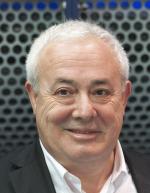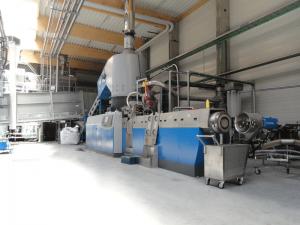Technical Report 2013-06-19
Content shown in the technical articles are the sole opinion and views of the authors or companies, which are not necessarily congruent to opinion and views of the editors.
|
Lindner reSource: Recycling agricultural film at a top quality level Harald Hoffmann, LINDNER reSource GmbH One of the most modern and powerful recycling plants for used agricultural film operates near the town of Champlon in Belgium. At this site, collected post-consumer film – often heavily soiled with foreign materials – is converted back into high-grade PE repellets (a much sought-after raw material for the film blowing industry) using machinery made by Lindner ReSource, Sorema and Erema. At its highest quality level, the recycled product even meets exacting specifications for the manufacture of stretch film.  Bild 1. Die Ballensilage gehört zu den bedeutendsten Anwendungen von PE-Stretchfolien in der Landwirtschaft – und ist damit eine der Hauptquellen für Folienabfälle aus diesem Bereich Recycling such film into new material is an exceedingly difficult and complex task since it is usually soiled heavily with mineral and organic matter and because the soft film, typically measuring only around 25 to 100 µm in thickness, does not lend itself easily to shredding, separation and cleaning. On the other hand, these films consist of valuable high-grade plastics such as PE-LD (low density polyethylene) and PE-LLD (linear low density polyethylene) which are keenly in demand, even in their recycled form. A high quality recyclate will therefore fetch good prices, justifying an appropriate treatment process. Waste collecting systems form a sound basis An effective collecting system is an indispensable prerequisite for running a high-performance recycling plant, which, for cost-efficiency, depends on the steady availability of collected waste streams in adequate amounts and consistent composition. In Germany, this supply is organized at the nationwide level by RIGK (www.rigk.de), for instance. In France, the corresponding scheme is handled by Adivalor (www.adivalor.fr). In the south of neighboring Belgium (i.e., the regions of Luxembourg and Lièges), the Recycling and Sanitation Division of the Idelux/AIVE (www.idelux-aive.be) intercommunal services association is in charge of the collection of agricultural films, netting and twine – beyond the collection and disposal of domestic waste. Jacques Counet, who manages the organization's own equipment pool and is also in charge of liaising with external disposal contractors, comments: “Each year, we collect up to 3,000 tons of used agricultural film to ensure its ecologically sound disposal. With Soreplastic SA, in which we hold a 42.5 % share, we now have a partner company which takes 100% of the incoming film off our hands and fully complies with our local treatment standards.” AIVE is a member of the Europe-wide group of organizations and companies who collect such materials and forward them to Soreplastic (Fig. 2). Film recycler closes the loop Soreplastic launched operations in late 2011 and focuses exclusively on the recycling of agricultural film. To this end, the owners invested around € 10 million in the erection of what is likely to be Europe's most advanced and powerful film recycling facility (Fig. 3). The plant is located near the Belgian city of Champlon in the Ardennes, in the immediate vicinity of a site where AIVE operates a biogas-based combined heat and power station. At present, the young company has a capacity of around 20,000 tons/year (related to incoming material) at this site. “The workflow is easily explained”, says managing director Vincent Sciascia. "We separate out coarse contaminants such as wood, rocks, soil and metals as well as incompatible agricultural plastic fractions such as twine or netting. Thereafter, we move the film through a series of shredding, washing and drying cycles. In the end we thus obtain a material which can be extruded into repellets. We sell these pellets to film manufacturers who again convert them into products, from bin liners to new agricultural film.” A critical customer with exacting demands Although the process is easily described, the technologies involved call for the use of cutting-edge equipment. Given the high value of the envisaged final product, Soreplastic invested a lot of time into comparing the machinery and equipment on offer in the marketplace. High throughput, low sensitivity to impurities, low wear costs and a constantly high product quality were the main evaluation criteria. “In addition, we required extensive support from the machine builders – from advice in the project development phase through customizing machines for our purposes, but also in terms of local presence from the first start-up to the plant's trouble-free continuous operation,” Mr. Sciascia continues.  Bild 3. In mehreren Stufen wird aus verschmutzter Landwirtschaftsfolie wieder hochwertiges Kunststoffgranulat – mit einer Kapazität von rund 1400 kg pro Stunde. Once it had shortlisted a number of manufacturers, the company proceeded to visit these vendors so as to test and compare the proposed equipment under near-real-life operating conditions. The products of Lindner ReSource, based in Grossbottwar (Germany) (www.lindner-resource.com), and Erema of Ansfelden/Linz (Austria) (www.erema.at), ultimately convinced the experienced recycling specialists. High-performance pre-shredder 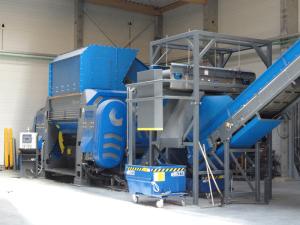 Bild 4. Der Lindner Universo 2800 mit nachgeschalteter Störstoffabtrennung als erste Station in der Folienrecyclinganlage von Soreplastic. Harald Hoffmann, managing director at Lindner ReSource, adds: “The power transmission between motor and rotor is achieved via a belt drive on this system. This so-called countershaft drive is equipped with a large safety clutch (slip clutch) which limits the maximum torque input and thus makes the shredder particularly insensitive to coarse foreign matter. With the special kind of films being processed at Soreplastic, this is particularly important since it cannot be ruled out that, e.g., metal parts will find their way into the shredder despite the pre-sorting step.” Mit einer stufenlos einstellbaren Betriebsdrehzahl von ca. 100 min-1 zieht der mit 86 Messern bestückte Rotor die Folienstücke besonders wirksam, gleichmäßig und staubarm ein. Die bei Soreplastic verfügbaren Siebe mit Lochdurchmessern von 50 mm bis 100 mm sind austauschbar, um den Shredder optimal an die jeweilige Foliencharge adaptieren zu können. Resultat dieser Vorzerkleinererstufe sind Folienschnitzel mit Abmessungen von 50 bis 100 mm. 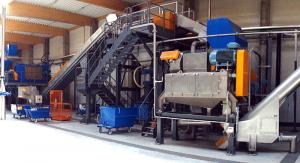 Bild 5. In der Nassschneidmühle werden die Folienschnitzel erneut gereinigt und auf rund 30 mm Größe gebracht “When we went down to Spittal to look at the Universo 2800, we were persuaded by its energy efficiency and performance,” Vincent Sciascia recollects. “Its modular design, based on a building block system, appealed to us very much because it allowed us to adapt ,our‘ preshredder perfectly to the application on hand. We also talked to other users who confirmed the system's ruggedness and reliability. Ease of maintenance was particularly important to us since with these machines, disruptions are no exception because of the inhomogeneous material being shredded. We liked the Lindner solution very much: an inspection and maintenance hatch can be hydraulically opened inwards, giving spacious access to the rotor area. We can thus conveniently rotate or replace the knives, each of which has 4 cutting edges, or any of the eight counter knives. Foreign parts, too, can be easily removed in this manner. The screen baskets can likewise be opened hydraulically so that we can clean or change the screen modules quickly if necessary. In our day-to-day operations, all this translates into short down times – a key prerequisite to cost efficiency.” Wash, cut and blow dry Nevertheless, the film pieces thus obtained are still contaminated with foreign matter that is difficult to remove because the thin shreds tend to adhere firmly to one another. As a next step, the pre-shredded material is therefore subjected to a washing cycle followed by downstream wet grinding and drying (Fig. 5). A sturdy recycling extruder line delivers repellets of constantly high quality Following this re-cleaning step and further size reduction to between 20 and 30 mm, the film shreds are ready – in terms of cleanliness and dimensions – to be fed to a recycling extrusion line converting them into pellets for the production of new blown film. Here, Soreplastic opted for an Erema 1716 TVEplus system which has been specially optimized for processing the washed PE shreds with their high initial moisture (Fig. 6). The film shreds exiting the wet grinder are still too large and too moist to be fed directly to the extruder. Ahead of the extruder, Erema has therefore inserted a patented multifunctional cutter-compactor in which the shreds are further reduced in size, dried and compacted. An air flushing module ensures that most of the residual moisture will evaporate from the pre-heated material. Moreover, the cutter-compactor acts as a buffer store from which pre-compacted stock is then supplied continuously to the directly connected single-screw extruder. Andreas Dirnberger, CSO at Erema, explains the particularities of this system (refer to the functional schematic in Fig. 7): “The material treated in the cutter-compactor still has low residual moisture and is not yet entirely free of contaminants. Our TVEplus system is designed specifically for such applications and hence, differs significantly from conventional extruders in some aspects. Its specially designed draw-in and melting zone promotes backward degassing in the direction of the extruder intake. Moreover, the melt filter is arranged ahead of the degassing station on TVEplus systems. Contaminants liable to degassing in the extruder are thus removed at a very early stage, and especially before the melt is homogenized. Only after it has passed the melt filter is the filtered melt subjected to homogenization; the degassing process is thus rendered much more efficient. The degassing zone is followed by the discharge zone from where the perfectly conditioned melt is fed to the pelletizing device.” 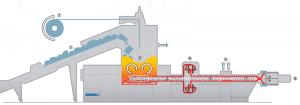 Bild 7. Funktionsschema der Erema Recycling-Extrusionslinie:
1: Beschicken, 2: Schneidverdichter, 3: Extruderschnecke, 4: vollautomatischer, selbstreinigender Filter, 5: Homogenisieren, 6: Entgasungszone, 7: Austragszone, 8: Granuliereinrichtung Soreplastic's 1716 TVEplus machine delivers an output capacity of approx. 1,400 kg/hr at a typical repellets batch size of 25 tonnes (Fig. 8). Vincent Sciascia summarizes: “Given the problematic nature of our charge material we were impressed in particular by the high process stability and high output of the Erema extruder system with its integral cutter-compactor. Moreover, it meets our need for highly rugged equipment and hence, low maintenance costs, compact space-saving design and fairly low energy consumption. This way, we produce top-quality repellets continuously and very economically. For our customers this means that they can make their finished products either entirely from repellets or at least with a very high percentage of recycled material.”  Bild 8. Das Endprodukt der Recycling-Aktivitäten bei Soreplastic: hochwertiges Regenerat für die Herstellung von Blasfolien For its power and water supply, Soreplastic benefits from the direct vicinity of the Idelux facility, Mr. Sciascia explains. “We receive the heat for our drying cycles from the nearby biogas-based heating power station. The service water for our processes comes from the intercommunal association's water treatment plant; we subject it to several cleaning cycles and to a final reconditioning treatment before discharging it back into the river.” The disposal of removed contaminants, which in terms of weight account for around half of the incoming material stream, is likewise ensured since Idelux operates a waste disposal facility at the same site. Thanks to this optimum infrastructure, which includes links to the Belgian transport route system plus the carefully selected equipment pool, the overall installation has been running trouble-free and with high cost efficiency after a two-month fine tuning period since its November 2011 commissioning date. “At present the facility is operating around the clock seven days a week 24 hours.” Sales of the high-grade PE repellets are ensured as well, Vincent Sciascia notes. „Our standard portfolio ranges from PE-LD through PE-LLD to customer-specific blends. At present, we are thus the only recycler capable of offering PE-LLD raw materials for blown film from washed agricultural stretch. As a result we have so many enquiries from film manufacturers all over Europe that we would not be able to meet demand even with all our equipment running to full capacity.“ First published im Recycling-Magazin 09/2013, page 30ff Lindner Washtech GmbH Häldenfeld 4 Phone: +49 (0) 7148 160538-0 Internet: www.lindner-washtech.com |
 back to the list back to the list |  back to top back to top |


